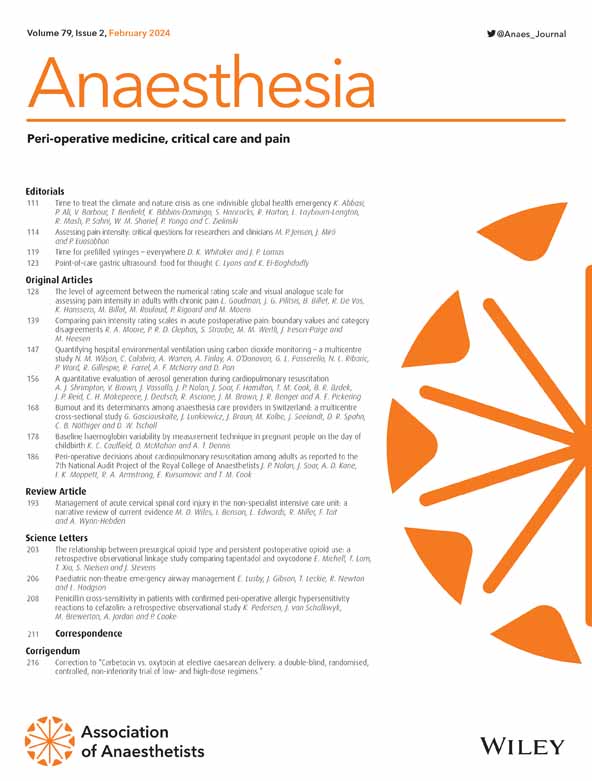不同给药途径地塞米松预防成人手术患者周围神经阻滞后反跳性疼痛的疗效:系统综述和网络meta分析
IF 7.5
1区 医学
Q1 ANESTHESIOLOGY
引用次数: 0
摘要
随着周围神经阻滞作用的减弱,以剧烈疼痛或不适为特征的反跳性疼痛仍然是一个临床问题。围手术期给予地塞米松可减少反跳性疼痛的发生率。本系统和网络荟萃分析旨在确定地塞米松给药预防反跳疼痛的最佳途径。方法根据预先确定的标准在数据库中检索随机对照试验。我们比较了静脉注射和神经周围地塞米松作为周围神经阻滞的辅助治疗,并将对照组作为常见的比较物。主要观察指标是反跳疼痛的发生率。利用累积排名曲线下的表面积计算出排名最高的干预措施的可能性。结果共纳入14项研究,1058例患者。与比较组相比,我们发现静脉注射地塞米松的效果最高,每1000人的反跳性疼痛减少298例(优势比(OR)(95%可信区间(CrI) 0.12 (0.03-0.44));中等确定性证据)。其次是神经周围地塞米松,预期效果为每1000人减少190例(OR (95%CrI) 0.34 (0.07-1.32);低确定性证据)。没有证据表明给药途径和反跳疼痛发作时间之间有影响。静脉注射地塞米松与降低周围神经阻滞后反跳性疼痛发生率的高概率相关。这是基于适度确定的证据。现在有必要进一步研究确定最佳剂量。本文章由计算机程序翻译,如有差异,请以英文原文为准。
Efficacy of different routes of dexamethasone administration for preventing rebound pain following peripheral nerve blocks in adult surgical patients: a systematic review and network meta‐analysis
SummaryIntroductionRebound pain, characterised by intense pain or discomfort as the effects of a peripheral nerve block diminish, remains a clinical problem. Peri‐operative dexamethasone administration may reduce the incidence of rebound pain. This systematic and network meta‐analysis aimed to determine the optimal route of dexamethasone administration for the prevention of rebound pain.MethodsWe searched databases for randomised controlled trials according to pre‐determined criteria. We compared intravenous and perineural dexamethasone as an adjunct to peripheral nerve blocks, with the control group as a common comparator. The primary outcome was the incidence of rebound pain. The likelihood of an intervention ranking highest was calculated using the surface area under the cumulative ranking curve.ResultsIn total, 14 studies with 1058 patients were included. When compared with the comparator group, we found that intravenous dexamethasone ranked the highest, with an anticipated effect of 298 fewer cases of rebound pain per 1000 people (odds ratio (OR) (95% credible interval (CrI) 0.12 (0.03–0.44)); moderate certainty evidence). This was followed by perineural dexamethasone with an anticipated effect of 190 fewer cases per 1000 people (OR (95%CrI) 0.34 (0.07–1.32); low certainty evidence). There was no evidence of an effect between the route of administration and time to onset of rebound pain.DiscussionIntravenous dexamethasone was associated with a high probability of decreasing the incidence of rebound pain following peripheral nerve block. This is based on moderate certainty of evidence. Future studies on identifying the optimal dose are now warranted.
求助全文
通过发布文献求助,成功后即可免费获取论文全文。
去求助
来源期刊

Anaesthesia
医学-麻醉学
CiteScore
21.20
自引率
9.30%
发文量
300
审稿时长
6 months
期刊介绍:
The official journal of the Association of Anaesthetists is Anaesthesia. It is a comprehensive international publication that covers a wide range of topics. The journal focuses on general and regional anaesthesia, as well as intensive care and pain therapy. It includes original articles that have undergone peer review, covering all aspects of these fields, including research on equipment.
 求助内容:
求助内容: 应助结果提醒方式:
应助结果提醒方式:


